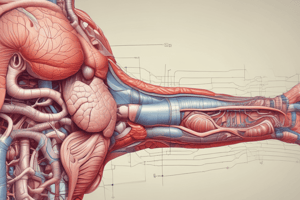Podcast
Questions and Answers
What is the primary function of peristaltic waves in the esophagus?
What is the primary function of peristaltic waves in the esophagus?
- To propel food from the mouth to the stomach through muscle contractions (correct)
- To initiate the breakdown of proteins into amino acids
- To neutralize stomach acid before food enters the stomach
- To absorb nutrients directly into the bloodstream
Which of the following enzymes is NOT produced by the pancreas?
Which of the following enzymes is NOT produced by the pancreas?
- Hydrochloric acid (correct)
- Amylase
- Lipase
- Protease
What is the main function of bile in the digestive process?
What is the main function of bile in the digestive process?
- To neutralize the acidic chyme entering the small intestine
- To break down proteins into amino acids
- To facilitate the absorption of carbohydrates in the small intestine
- To emulsify fats, aiding in their digestion and absorption (correct)
Where does the majority of nutrient absorption take place?
Where does the majority of nutrient absorption take place?
What is the role of bicarbonate released by the pancreas in digestion?
What is the role of bicarbonate released by the pancreas in digestion?
Which of the following is NOT a function of the liver in the digestive system?
Which of the following is NOT a function of the liver in the digestive system?
What is the primary function of the large intestine?
What is the primary function of the large intestine?
Which hormone is NOT involved in regulating digestive processes?
Which hormone is NOT involved in regulating digestive processes?
Which digestive process involves the physical breakdown of food, such as chewing and stomach churning?
Which digestive process involves the physical breakdown of food, such as chewing and stomach churning?
What is chyme?
What is chyme?
Flashcards
Digestive System
Digestive System
A network of organs and glands that breaks down food for nutrient absorption.
Mechanical Digestion
Mechanical Digestion
Physical breakdown of food, such as chewing and stomach churning.
Chemical Digestion
Chemical Digestion
Breakdown of food using enzymes to convert it into absorbable nutrients.
Chyme
Chyme
Signup and view all the flashcards
Villi
Villi
Signup and view all the flashcards
Liver Function
Liver Function
Signup and view all the flashcards
Pancreas Role
Pancreas Role
Signup and view all the flashcards
Large Intestine
Large Intestine
Signup and view all the flashcards
Digestive Hormones
Digestive Hormones
Signup and view all the flashcards
Accessory Organs
Accessory Organs
Signup and view all the flashcards
Study Notes
Overview of the Digestive System
- The digestive system is a complex network of organs and glands working together to break down food into absorbable nutrients
- This process involves mechanical and chemical breakdown of food, absorption of nutrients, and elimination of waste
- Key organs include the mouth, esophagus, stomach, small intestine, large intestine, liver, pancreas, and gallbladder
Mouth
- Food intake begins in the mouth where mechanical breakdown (chewing) occurs
- Saliva contains enzymes (amylase) that initiate carbohydrate digestion
- Tongue manipulates food for chewing and swallowing
Esophagus
- Muscular tube that transports food from the mouth to the stomach
- Peristaltic waves (muscle contractions) propel food downwards
Stomach
- Stores food, mixes it with gastric juices, and initiates protein digestion
- Gastric juices contain hydrochloric acid (kills bacteria) and enzymes (pepsin)
- Stomach muscles churn food, breaking it down mechanically
- Chyme (partially digested food) is produced
Small Intestine
- Major site of nutrient absorption
- Divided into three sections: duodenum, jejunum, and ileum
- Receives secretions from pancreas and liver
- Villi and microvilli increase surface area for absorption
- Enzymes from the pancreas and small intestine complete digestion of carbohydrates, proteins, and fats
- Nutrients are absorbed into the bloodstream and lymphatic system
Liver
- Produces bile, crucial for fat digestion
- Filters blood, detoxifies harmful substances
- Stores glycogen
- Synthesizes proteins and other essential compounds
Pancreas
- Produces pancreatic juice containing enzymes (amylase, protease, lipase) and bicarbonate to neutralize stomach acid
- Releases hormones like insulin and glucagon to regulate blood sugar levels
- Plays a vital role in digestion
Gallbladder
- Stores and concentrates bile produced by the liver
- Releases bile into the small intestine to aid in fat digestion
Large Intestine
- Absorbs water and electrolytes from indigestible food matter
- Forms and stores feces
- Contains bacteria that aid in fermentation of some material
- Eliminates waste from the body
Accessory Organs
- Salivary glands, liver, pancreas, and gallbladder are considered accessory organs
- They produce and secrete substances that are necessary for digestion
Digestive Processes
- Mechanical digestion involves physical breakdown of food (chewing, stomach churning)
- Chemical digestion involves breakdown of food using enzymes (amylase, protease, lipase)
- Absorption is the process of taking nutrients into the bloodstream for use by the body
- Elimination is the process of removing undigested food waste from the body as feces
Digestive System Disorders
- Common issues include heartburn, indigestion, diarrhea, and constipation
- More serious conditions include Crohn's disease, ulcerative colitis, and cancer
- Symptoms can range from mild discomfort to severe pain and dysfunction
- Lifestyle factors, diet, and medical conditions can induce or exacerbate complications
- Accessing medical advice for proper diagnosis and management is essential
Regulation of Digestion
- The nervous system (hormones and nerves) controls the coordinated functioning of different parts of the system
- Hormones (gastrin, secretin, cholecystokinin) regulate secretions
- Neural reflexes influence muscle contractions and secretions
- This complex interplay ensures efficient processing and absorption of nutrients
Studying That Suits You
Use AI to generate personalized quizzes and flashcards to suit your learning preferences.




